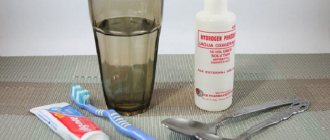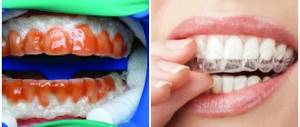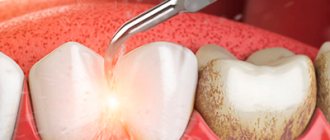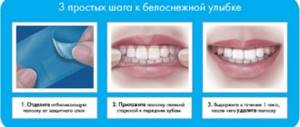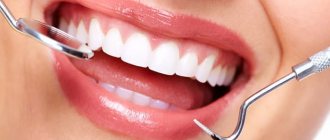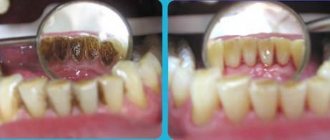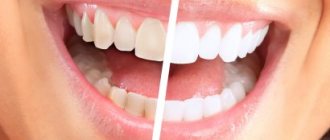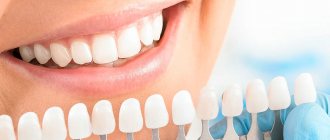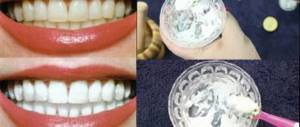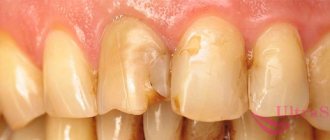Possibility of combination with other means
In addition to soda and hydrogen peroxide, other means are used to whiten things, which can be safely combined with the first two:
- table salt (suitable for synthetic fabrics, wool and silk);
- ammonia (cotton, linen, wool, silk, delicate fabrics);
- potassium permanganate (suitable for all types of fabric);
- mustard (suitable for all types of fabric).
You cannot add any professional bleaches (alkaline, chlorine, oxygen) to soda or hydrogen peroxide in order to enhance the effect of the former. This can lead to unforeseen consequences, such as yellowing or deterioration of the fabric.
How to wash faded items
Before you bleach your laundry with soda and peroxide when other things have stained it, you need to learn the basic rule: you need to get rid of dirt as quickly as possible. The first remedy is repeated washing with the addition of a double portion of a special detergent for washing whites, strengthened with soda ash (in a ratio of ten to one). If this method did not help or the color damage was not detected immediately, there are more radical methods:
We recommend:
How to dissolve Moment glue
- Cotton linen can be boiled with the addition of hydrogen peroxide and ammonia. For a bucket of water you need a glass of hydrogen solution and 15 milliliters of ammonia, the boiling time should be up to half an hour;
- You can try to revive linen, denim, thick cotton with the help of soda paste. The water-soda slurry is applied to the stains locally, left for 20 minutes, after which the entire item is sent for washing;
- synthetic fabrics can be saved with soapy water. To do this, dissolve a crushed piece of laundry soap in half a liter of water, add two tablespoons of peroxide and five ammonia. The finished mixture is poured into a bucket of warm water, where the faded synthetics are soaked for half an hour before washing.
Rules for using baking soda and hydrogen peroxide for whitening
These products are considered gentle and suitable for bleaching items made from various fabrics.
Bleaching of cotton and linen products
The simplest way to bleach cotton items is to soak them in a solution of hydrogen peroxide. To do this you need:
- Wash items using powder.
- Dilute 1 tsp. peroxide in 2 liters of warm water.
- Soak the items in this liquid for 20 minutes, turning the items over every 5 minutes.
- After soaking, items should be rinsed thoroughly. No re-washing required.
Cotton fabrics can be boiled for an additional 30 minutes. This should be done as follows:
- Soak clothes or linen in a soda solution (6–7 tablespoons per 7 liters of water at 40°C).
- Then place in a large enamel bowl, add water (5 liters of water per 1 kg of laundry) and add washing powder.
- Boil for 30 minutes, stirring occasionally or turning things over with tongs.
Only cotton products can be boiled
You can remove traces of sweat with hydrogen peroxide only on cotton products. To do this you need:
- Apply hydrogen peroxide to the stain.
- Wait 3–5 minutes.
- Rinse in cool water.
- If necessary, repeat after the product has dried.
For linen products, it is better to use soda ash. It effectively fights yellow spots from sweat:
- Pour soda ash (1 tbsp for a full load) into the powder tray of the washing machine. At the same time, you cannot add other laundry detergents, especially bleaching agents.
- Set the washing mode to 70° followed by rinsing.
- Repeat washing with regular powder.
Bleaching of synthetic fabrics
Synthetic fabrics can only be bleached at low temperatures. A mixture of soda and ammonia is effective:
- Mix 2 tbsp in 10 liters of water. l. ammonia, 10 tbsp. l. soda
- Soak the laundry in this mixture for 3 hours.
- After this time, rinse the items and then wash them.
If the cause of the graying of synthetic fabric was careless washing, it is unlikely that it will be possible to revive such a product. In addition to the fact that such products change color, pellets also form on the surface, which generally spoils the appearance of the product.
You can remove yellow stains that appeared as a result of washing in water with rust from synthetic products as follows:
- Mix 10 liters of water and 200 ml of hydrogen peroxide.
- Soak damaged items in this mixture for 2 hours.
- After this, rinse and wash in clean water. It must be remembered that synthetic products cannot be wrung out after bleaching and dried in direct sunlight.
A mixture of hydrogen peroxide and soda ash will also help to bleach synthetic products:
- Pour 10 liters of water at a temperature of 30° into a plastic container.
- Add 30 ml of hydrogen peroxide and 2 tbsp. l. soda ash.
- Soak clothes for 20–30 minutes, then rinse and wash.
Bleaching of wool and silk products
Wool and silk are fabrics of animal origin. The peculiarity of bleaching these fabrics is that when bleaching and rinsing the products, you need to use water at the same temperature.
Hydrogen peroxide is also an effective stain remover when bleaching wool or silk clothes. The whitening instructions are as follows:
- Fill a 10-liter bucket halfway with water.
- Dilute 1 tbsp in it. l. powder for white delicate products, 4 tbsp. l. table salt, 1 tbsp. l. hydrogen peroxide and ammonia.
- Soak items with yellow stains in this solution for two hours.
- Rinse the items in cold water, then add vinegar (1/4 cup per 5 liters of warm water) and wash.
Woolen items can be soaked in a soda solution before each wash. Add 50 g of soda to 5 liters of water. Soaking duration is 15–20 minutes.
You can bleach wool products using only hydrogen peroxide, but you will need a large amount of it:
- You need to mix hydrogen peroxide with cool water in a ratio of 1:8.
- You need to soak things in this solution for 5–7 hours (you can leave them overnight, the product will not be damaged).
- Remove items from the solution (no additional rinsing is required) and dry in fresh air, but away from direct sunlight.
Universal means
There are several ways to use baking soda to whiten whites. The first involves the use of soda and ammonia:
- First prepare a solution by mixing 5 liters of water, 5 tbsp. l. baking soda and 2 tbsp. l. ammonia.
- Soak grayed items in this solution for 3–4 hours.
- Wash items by hand or in a washing machine, or simply rinse with cool water. The whitening effect will be in both the first and second cases.
White clothes turn gray from frequent washing
If there are yellow spots on clothes, you can use soda paste:
- Dilute baking soda in water to obtain a paste-like mixture.
- Apply this mixture to the stains, rubbing it in as hard as possible with your fingers.
If you need to remove faded stains from white things, it is recommended to use soda paste rather than a solution. - Leave for 30 minutes.
- Clean the paste from the surface of the product.
- Wash the item using powder. After drying, repeat if necessary.
I often use the last recipe to whiten the cuffs of my daughter’s blouse. The item itself is black, but its cuffs are white, which is why it has to be washed more often. I couldn’t get the blouse (or rather, the white part of it) to soak, so I reduced the amount of water. Mix soda, ammonia and a little water until you get a paste. I smeared it on the cuffs and left it for an hour. Then rinsed thoroughly. I won’t say that the cuffs have become crystal white, but they are no longer gray. I don’t risk using the product often, in case the fabric gets damaged.
To bleach gray fabric (the method is suitable even for delicate fabrics) with hydrogen peroxide, you need to follow the instructions:
- Pour hot water into a large container. If it is silk or wool, then the water temperature should not exceed 40°.
- Add 2 tbsp. l. hydrogen peroxide and ammonia for every 10 liters of water.
- Soak the damaged item in the resulting solution for 30 minutes.
- Wash the item in the usual way, using a powder suitable for this type of fabric.
Video: washing underwear
Ways to restore the color of a faded item
When restoring the color of a white item, it is important to immediately take action. The product should be washed again with a large amount of white powder with the addition of a small amount of soda ash. If this measure did not give a positive result, or if the problem was not detected immediately, then the following methods can be used:
- digestion with ammonia and hydrogen peroxide - the method is used to restore the color of bed linen and other cotton products (add 15 ml of ammonia and 200 ml of hydrogen peroxide to 10 liters of water, the mixture can be used for cotton fabrics);
- applying soda paste to dense fabrics (mix soda with water to form a paste, apply to problem areas and leave for 20 minutes, then wash the product);
- soaking in a solution of hydrogen peroxide and washing powder - the method is effective for delicate fabrics (add hydrogen peroxide in a ratio of 1:10 to water, and then add 25 g of washing powder, soak the items in the liquid for 2-3 hours, then rinse the items) ;
- bleaching with a mixture of ammonia (5 tbsp), hydrogen peroxide (2 tbsp), a strong solution of laundry soap (grate 1 bar of soap and dissolve in 0.5 liters of water) - this way you can bleach synthetic items (the resulting dissolve the mixture in 10 liters of water, then soak the damaged items in the solution for 30–35 minutes, and then rinse)
How to creatively whiten jeans
Sometimes simply changing the color of your favorite denim pants may not be enough. To give the product more originality and make it even more unusual, you can create a non-trivial design using creative home bleaching of some areas of the jeans.
How to bleach threads on jeans
If the jeans are torn, with artificial abrasions, the threads can be bleached and thereby emphasize them. An interesting solution would be to lighten the seams on the sides using bleach: this way you can diversify the design.
In order to make the threads a tone lighter at home, you need to apply a special bleaching agent to them, wait a little and rinse. Most likely, powerful household chemicals will not be needed, since the fibers of the fabric are already quite light. Sometimes it makes sense to resort to traditional methods: hydrogen peroxide or soda.
How to lighten a spot on jeans
Local highlighting on denim trousers is used to create accents. This is a great life hack for those who want to hide fullness in the hip area. It’s easy to achieve this at home by following these tips:
- Decide in advance which areas need to be bleached.
- Prepare a lightening agent - you can take household bleach or a more gentle folk equivalent (soda, chalk, peroxide or ammonia). Then mix it with a little water.
- Using a sponge or cloth, apply the resulting mixture to selected areas of the product for at least 10 minutes.
- Wash the item in the usual way.
How to bleach fringe on jeans
Denim trousers with uneven hems are still on trend. You can slightly diversify their appearance at home by lightening the fringe. This is very easy to do using a simple method:
- it is necessary to prepare a mixture - hot water and a small amount of bleaching agent (for example, bleach);
- then wet a sponge or rag with the solution (or pour it into a bottle with a spray nozzle);
- blot the ends of the threads with a sponge or sprinkle with a lightening mixture;
- after 5 minutes, rinse the product in cold water and wash.
How to bleach jeans in a washing machine
Bleaching clothes in an automatic washing machine is the most gentle and easiest way to make a product lighter. Home procedure algorithm:
Prepare your jeans in advance: fasten buttons and zippers, remove everything from pockets. Pour the composition with the addition of a bleach into the powder sector: it can be either a drop of whiteness or one of the popular analogues - citric acid, hydrogen peroxide (in tablets) or vinegar. Run a delicate cycle (it is important to remember not to use too hot water for jeans, otherwise they will lose their shape and shrink). At the end of the process, the product must be thoroughly rinsed in cold water.
Reviews
Add a little baking soda and salt each time you wash. If you wash in an automatic machine, then 2 tsp will be enough. salt and 3 tsp. soda Of course, the laundry will not whiten the first time, but gradually it will return to its previous appearance. Dilute 2 tbsp. l. hydrogen peroxide in a liter of water and soak the laundry in the resulting solution. Peroxide perfectly whitens and refreshes the color of fabric.
Oksana
Read the topic about peroxide. She began to whiten and remove stains. I wouldn't trade it for anything.
Larubia
https://www.u-mama.ru/forum/family/housewife/595872/
I threw white clothes into hydrogen peroxide to boil, it washed off, but not completely, then I threw it in the washing machine at 90° and everything was ok.
Guest
Using baking soda and hydrogen peroxide to bleach items will help preserve the structure of fabric fibers, and there is no doubt about the effectiveness of these products. They can be safely used for bed linen and for a silk blouse. The main thing is to strictly observe the proportions.
Features of whitening at home
Most housewives have their own secrets on how to keep white things snow-white for longer. It is impossible to find one universal technique that is suitable for all white things, because they are made from fabrics of different compositions and textures. Given these features, it is necessary to use different bleaching products for each item. Another feature is the temperature regime. It is selected for each fabric separately.
Very often, white things become yellowish or gray due to the hardness of the water. Detergents react to tap water, which contains large amounts of salts.
White textiles are recommended to be washed separately from other laundry. Otherwise, colored items may fade, which will give white items an undesirable tint. Cotton and linen items should be separated from wool and synthetic items. If you wash them together, then a yellowish and gray tint may appear.
White items can turn yellowish if they sit for a long time. When they become dirty, you should immediately try to wash them. Dirt and stains of various origins on such things are then more difficult to wash off.
If the clothing is not pure white, but is combined with another color, then it may fade from the pattern or color insert. To prevent this from happening, it is recommended to add a small portion of table salt during washing.
Very frequent use of various bleaching agents leads to rapid wear of linen. Fabric manufacturers advise using bleaching agents after 3-4 washes with powders. Be sure to rinse things thoroughly after bleaching.
It is advisable to boil yellowed laundry with detergents. It is also worth adding ammonia to this composition: for 1 bucket of water, 1 tablespoon of ammonia solution. This method can only be used for white fabrics with a dense texture.
Contraindications
Using any means to whiten tooth enamel can either help or harm. Before you start using them, you should consult with your dentist and take into account the characteristics of your oral cavity.
There are a number of contraindications for using cleaning and whitening teeth with soda, peroxide and lemon. These include:
- Bleeding gums, periodontal disease.
- Presence of oral diseases.
- Thin enamel - soda with abrasive particles erases its top layer.
Advice. To achieve the desired effect when whitening your teeth, you should remember that their natural color is slightly yellowish. You shouldn’t go against nature and make it unnaturally snow-white. This is fraught with further dental problems. Once visible results are achieved, use whitening methods no more than once every two to three months.
Remember - it is easier to destroy than to build. Love yourself and take care of your teeth!
Common Remedies
There are many common methods of bleaching at home, and you can use them to whiten clothes, depending on your specific situation. Not every product is suitable for all types of fabrics. If used incorrectly, you can damage your laundry. Housewives mainly use it for whitening:
- baking soda;
- table salt;
- hydrogen peroxide;
- ammonia solution;
- potassium permanganate;
- mustard.
When bleaching synthetic items, do not use products containing chlorine . Most often, such bleaching agents only worsen the condition of synthetic products; they turn yellow. Also, synthetic items should not be boiled or dried in the sun .
In addition to available home remedies, housewives very often use household chemicals purchased in the store. There are a lot of them on sale now. When purchasing such products, you need to consider their purpose, since they are not always suitable for all types of fabrics. If used according to instructions, they can return white items to their original color. Let's look at the most popular methods of how to bleach laundry in the simplest ways.
Hydrogen peroxide
This method is very effective if you use 3% hydrogen peroxide. It is effective and allows you to very quickly give your laundry a beautiful fresh look in just half an hour. Using a simple substance you can bleach almost all fabrics. To do this you need to take:
- 1 tbsp. hydrogen peroxide;
- 6 liters of warm water.
Baking soda and hydrogen peroxide
Washing soda is very often used as a separate component. It is also very good to use in combination with soda ash . These two components are completely safe for health, so they can be used for washing baby clothes. Soda ash has the property of softening water, which is very important when washing in hard water.
To prepare a washing solution, you need to take 6-7 tablespoons of baking soda and dilute it in 7 liters of 40 o water. In order to get more snow-white laundry, you should add 1 tablespoon of hydrogen peroxide. Things should sit in this solution for at least 2 hours. If there are heavily contaminated areas, then directly apply baking soda to them and rub it . The textiles can then be boiled.
Salt and potassium permanganate
This method is ideal for bleaching cotton and wool items. You need to take 3 tablespoons of salt and dissolve it in warm water, and also add regular washing powder as for washing. Some housewives add a couple of tablespoons of ammonia to enhance the effect.
Potassium permanganate has a positive effect on white items when washing . For 10 liters you need to add only 5 manganese crystals. A couple of tablespoons of washing powder and a little crushed laundry soap are also added to the solution.
When all the components are completely dissolved, then you can load things. It is best to leave laundry in this solution overnight. After this, the laundry should be rinsed well and washed with regular washing powder in the machine or by hand.
